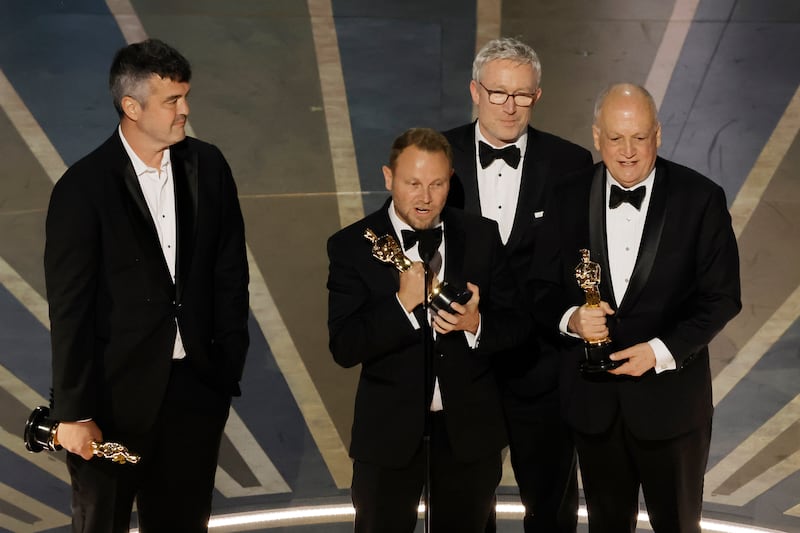The phenomenal success of Ireland’s film industry evidenced by the constellation of award-nominated Irish stars at the Oscars and Baftas reflects a huge amount of creative talent behind this golden age of Irish screen. The number of trophies acquired this year alone across diverse categories is exhilarating but not entirely unexpected. It’s the culmination of years of hard graft by screenwriters, film-makers, visual-effects artists and many others, coupled with arts grants, tax-break initiatives and greatly improved third-level film education.
As our reputation grows, we can speak fluent name-drop, with the likes of Jessie Buckley, Ruth Negga, Colin Farrell, Paul Mescal, Brendan Gleeson, Barry Keoghan and Saoirse Ronan peppering conversations. They are the screen ambassadors of a dynamic storytelling industry and ambitious film-production teams.
Creating a sustainable industry
The Irish screen industry has also benefited greatly from increased support under Minister for Tourism, Culture, Arts, Gaeltacht, Sport and Media Catherine Martin for creating hit films and television shows such as The Banshees of Inisherin, Bad Sisters, Room, and Normal People, to mention just a few. However, to ensure continued growth, there is a need to take sustainable measures to ensure the industry is equipped to respond to increased demands for crew, facilities and resources across film and television production.
Screen Ireland, Screen Producers Ireland, Animation Ireland and the Visual Effects Association of Ireland (VFXAI) together provide a strong network of marketing advice and incentives to help with the arduous journey from script to screen. Enterprise Ireland is also a key player for making connections within the sector and setting up marketing meetings and introductions to interested vendors and investors.
READ MORE
“Ireland has long produced talented artists across film-making and audio-visual production but it is the collective success of the industry in recent years that has pointed to a significant change in the overall industry’s trajectory as an international hub,” says Louise Ryan, head of marketing and communications at Screen Ireland.
“We recently announced that €3.5 million in funding has been ring-fenced for regional production activity. Both local and international production activity can provide a number of benefits to counties around Ireland including high-quality jobs, opportunities for skills development and spend in the local economy attracted by screen tourism.”
Screen Ireland’s Skills Challenge Report for 2023 concluded that some issues remain in bridging the gap between third level and industry skills needs. However, there has been significant progress in recent years, with third-level courses becoming more industry focused, emphasising apprenticeships, certification for work-based learning and increased awareness of the range of careers available in the sector.

Visual effects is a growing sector
Jake Walshe is chair of the VFXAI, which represents Ireland’s high-tech visual-effects companies, including Screen Scene, Windmill Lane, Egg, Element, Outer Limits and Piranha Bar, which supply major international film studios with computer-generated visual effects, 3D animation and compositing.
“The VFX market is a growing sector and it’s geographically agnostic,” Walshe explains. “Bolstered by streaming platforms like Netflix, Paramount, Disney, Amazon, and Apple, the convenience of digital connectivity means the client can review and supervise the project as if they were actually in the room – with virtual reality at their fingertips. Another advantage of producing VFX in Ireland is the availability of multiple vendors in the same time zones that can work together collectively.”
Films are superb for VFX business but long-running series and dramas are excellent for sustainability and nurturing longer-term employment contracts and talent
— Jake Walshe
The Irish post-production and VFX sector has now become a leading hub for large-scale productions and is competing at the highest levels internationally. Recent work includes some of the most successful films and TV series in the world including Stranger Things, The Woman King, Discovery of Witches, Intergalactic and several Marvel blockbusters. Richie Baneham, an alumnus of Ballyfermot College, recently picked up his second Oscar, for VFX work on Avatar: The Way of Water, while Dubliner John Redmond was nominated for best film editing on the Elvis biopic.
“Films are superb for VFX business but long-running series and dramas are excellent for sustainability and nurturing longer-term employment contracts and talent,” adds Walshe. “We would like to see the government giving more competitive tax breaks for VFX companies.”
Competitive tax breaks
At the moment under Section 481 the government offers a tax credit of 32 per cent on a ‘per project’ basis capped at 80 per cent of the total cost of production but only up to €70 million. Once they reach the cap of €70 million the production companies are more likely to complete the visual effects and editing processes in more competitive countries. Meanwhile, we are competing with the likes of the French tax break, which offers an additional 10 per cent uplift if the VFX is completed in France.
Susan Kirby chief executive of Screen Producers Ireland, says the 481 tax initiatives should be reviewed swiftly to harness the potential that exists in the sector to attract larger productions to Ireland.
“Ireland could also introduce a levy on streaming services and other broadcasters that could be used to invest in indigenous Irish productions. While the Government has legislated for its introduction, there is still no clear timeline for when it will come into operation, with some projections predicting 2027,” adds Kirby. “This delay could cost tens of millions in potential investments in the sector and needs to be addressed.”

Continued industry expansion
Ireland has plans to increase film-studio infrastructure from 300,000 sq ft to 1,000,000 sq ft within a two-to-five-year timescale but this needs action as both Ardmore in Co Wicklow and Troy in Limerick are reaching full capacity. The 36-acre Troy Studios, which recently developed the Apple series Foundation, employing more than 500 people, is Ireland’s largest facility. There are currently plans for other studios in Wexford, Greystones, Skibbereen, Galway, and Mullingar, with talk of further expansion at Ashford Studios, also in Co Wicklow.
Educating the future generation is key to continued expansion. “Screen Ireland works closely with industry stakeholders to deliver diverse technical skills encompassing TV, animation, games and VFX,” says Ryan. “Ireland is set to open five film academies, including one specialising in animation, to keep up with the rising interest in film production.
“By establishing a network of academies across film and television, we can support regional talent and crew-based training. In 2022 there were more than 3,500 student placements including mentorships, shadow directing and other initiatives with a focus on diversity and inclusivity. Our recent partnership with Technical University Dublin is part of a wider project to aid career progression and certification.”
Animation nation
The animation industry continues to make headlines, with companies including Cartoon Saloon, Boulder and Brown Bag proving that Ireland is a global hub for creative excellence. It is a notoriously expensive area of the film industry that is time-consuming and highly competitive. In 2019 this sector quadrupled in size and accounted for almost 50 per cent of Irish production spend. The focus now turns to sustainable, steady developments in the exploration of new formats.
With major Irish animation studios at the forefront globally, the commercial and critical success of Irish animation can be attributed to technical skills and stunning visual artistry.
Education is essential to equipping a confident generation of media-savvy students with multi-disciplinary skills, ensuring a highly skilled pool of talent to deploy in specialised areas.
Big plans for 2023
This year’s production slate contains more than 40 projects in multiple genres that include nine feature films, three animation series, eight TV dramas, thirteen documentaries and seven short films.
John Carney, who directed Eve Hewson in Flora and Son, was delighted to have his film picked by Apple TV after its premiere at the Sundance Film Festival. “It’s beautiful to see a small island nation come up against the giants of Hollywood through years of seeding and financing talent,” Carney says. “To see our actors, directors, writers and producers accepted and celebrated overseas in numerous festivals, theatres and awards is a testament to arts funding and would be next to impossible without the support and cultivation of talent. In the film business particularly, be wary of anyone who tells you they’ve done it on their own. It’s an art form that is simply impossible without generous support.”
The Irish film industry is on track for growth, creating local jobs and welcome spend in the Irish economy. Our successful dramas, films and animation ensure that Irish stories, artistry and creativity are enjoyed worldwide. And this international profile presents an opportunity to ensure that Ireland becomes a go-to destination for major film productions.















